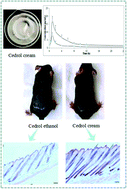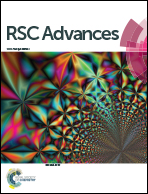Hair growth promotion effect of cedrol cream and its dermatopharmacokinetics
Abstract
Topical use of cedrol ethanol has been reported to have a beneficial effect on hair loss. However, the use of cedrol has been limited by application-related issues, such as poor water solubility and volatile features. Therefore, the present study developed a cream formulation of cedrol and evaluated various physicochemical parameters of the prepared cream. The optimized cedrol cream was selected after orthogonal tests and determined further. The dermatopharmacokinetics were studied to investigate the absorption difference between cedrol cream and cedrol ethanol after dermal application, and the concentrations of cedrol in skin were analysed by the gas chromatography-mass spectrometry (GC-MS) method. By comparison, the area under the curve (AUC0–24 h) of cedrol cream was almost three times higher than that of cedrol ethanol. Moreover, this study was undertaken to evaluate the hair growth promoting efficacy of cedrol cream in C57BL/6 mice and Wistar rats. Macroscopic assessment and alopecia score showed that C57BL/6 mice treated with cedrol cream showed a faster production of pigmentation and a higher score at different growth stages than other groups. The hair length of the cedrol cream-treated group was much longer than those of the cedrol ethanol and minoxidil groups. Histological analyses indicated that in the cedrol ethanol group, most follicles of the C57BL/6 mice were in the catagen phase, whereas nearly 83% of hair follicles in the cedrol cream group remained in the anagen phase. Taken together, our data strongly suggest that the cream formulation of cedrol has a stronger hair growth promotion effect, gave no irritation and was safe for topical administration.



 Please wait while we load your content...
Please wait while we load your content...